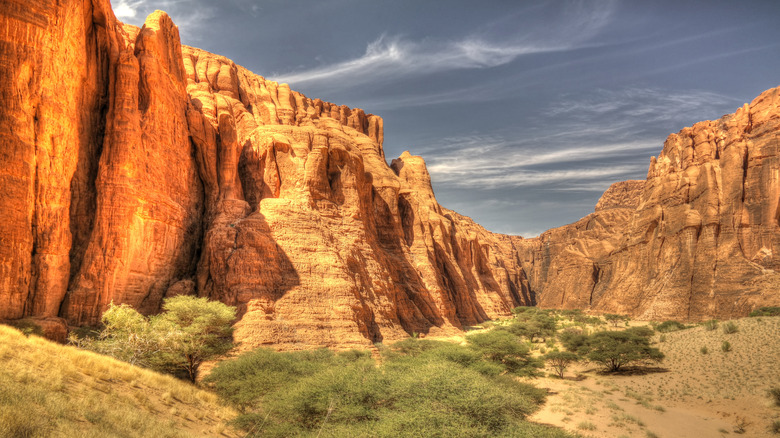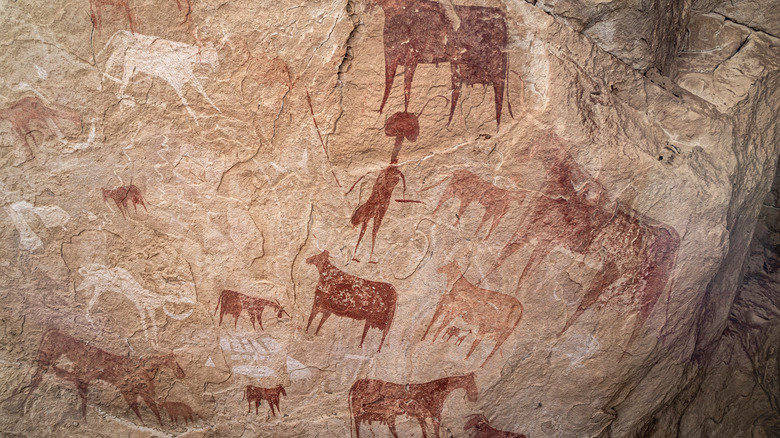The Ennedi Plateau of Chad is an awe-inspiring region within the Sahara Desert, the world’s largest hot desert. The Ennedi region is known for its unique geological formations, such as towers, pillars, and bridges, formed over millions of years of erosion caused by wind and water. The most famous of these natural wonders is Aloba Arch, which stands as one of the largest natural arches in the world. The Aloba Arch is a breathtaking natural wonder with an impressive span of about 250 feet and a towering height of 394 feet, making it one of the 10 largest arches in the world. Of these, Aloba Arch is the only one not located in either the United States or China but in the remote wilderness of Chad.
Despite its grandeur, visiting the Aloba Arch can be quite challenging due to its remote location and the harsh environment surrounding it. The wilderness of Chad is not easily accessible, and visitors must take adequate measures to ensure their safety during their journey. However, those who dare to explore the region will be rewarded with the secrets of the Aloba Arch’s formation and the stories etched into its stone. By studying this natural wonder, we can learn about the challenges that have kept it hidden for so long and gain a deeper appreciation for the beauty of the Ennedi region.
Access challenges of the Aloba Arch

The Aloba Arch began as sedimentary rock layers deposited over time, which changed due to pressure and movement beneath the Earth’s crust. Over millions of years, the region experienced uplift and subsidence, leading to extensive rock formations and deep canyons. The arch appeared as softer rock layers eroded more quickly than the harder layers above, resulting in a bridge-like structure that has withstood the test of time. The sedimentary layers reveal the region’s geological history, with each stratum bearing witness to different epochs in Earth’s evolution.
The best time to visit Aloba Arch is between November and February, when the temperatures are milder. However, getting to the arch is a challenging journey that requires navigating deep canyons, rocky outcrops, and desert trails. Specialized vehicles and experienced guides familiar with the area are necessary for the journey. Even aerial access can be challenging due to the harsh flying conditions in the territory. Additionally, accessing the arch requires obtaining the necessary permits and permissions since the Ennedi Plateau is protected.
Travelers should be aware that the region’s extreme climatic conditions, with scorching temperatures during the day and plummeting temperatures at night, make the journey even more challenging. Additionally, the U.S. Department of State has issued a travel advisory for Chad, recommending that travelers think about their plans twice due to crime, terrorism, civil unrest, and kidnapping.
History and culture of the Ennedi Plateau

The Ennedi Plateau has been inhabited by various groups of people for centuries, and as a result, they have developed an unbreakable bond with the landscape. This area is famous for its rock paintings and carvings that date back to the Neolithic era, which is considered one of the most significant examples of prehistoric art in Africa. These ancient artifacts offer a glimpse into the lives of the people who have lived in the region for thousands of years, providing us with a rich and detailed history of the area.
Currently, the Ennedi Plateau is home to a few semi-nomadic groups that continue to follow traditional lifestyles. Despite the changes that have taken place in the world around them, these livestock herders and their families have managed to preserve many customs and traditions, making the region a treasure trove of cultural riches. Although the Ennedi Plateau’s isolation presents some obstacles, it also helps preserve its pristine beauty and cultural significance. The region’s remoteness has helped protect its natural resources and cultural heritage from outside influence, ensuring that the area remains a unique and important part of Africa’s history and culture.

